I recently made my way to downtown Los Angeles to view Oneira: I Dream the Self, a group exhibition which dealt with the personal interpretation of dreams from a female perspective. Oneira was organized by Peggy Nichols, an artist who has transformed her working space at the Santa Fe Art Colony in Los Angeles into an open-by-appointment gallery and also a space for artist's workshops. Her creation -- Studio C Gallery -- is dedicated to exhibiting and emphasizing the work of women artists as a vehicle in bringing attention to the feminine characteristics and trademarks of art making.
After the show closed I was able to interview Peggy and ask her more about her gallery, the exhibition, and the the current situation of women artists.
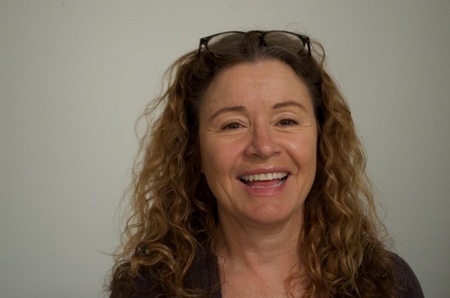
Peggy Nichols: the founder of Studio C Gallery
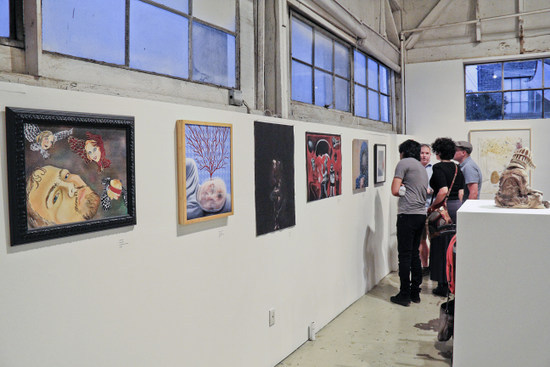
Visitors at Studio C Gallery at the opening of the exhibition Oneira: I Dream the Self
Tell me how you got started giving shows in your studio? Also, what was the theme of the show you gave last year?
It's taken some time to find a "real" studio. I lived 20 years in a one bedroom apartment. I substituted a studio with a homemade tent that I had built out in the backyard. It was about the size of a pop up. It was ideal for awhile but became too small a space, as I started to produce larger work.
I have often dreamed of having a sizeable enough studio where I could do my work but also create a salon type atmosphere, where other artists could come teach or share their work. This dream materialized about three years ago when I found a 2,200 sq. ft. studio space available at the Santa Fe Art Colony, in downtown Los Angeles. I jumped at the chance without hesitation.
Studio C Gallery started from doing a two person show with my studio mate. That show received such a great response, I decided to do another show the following year. I had often thought of collaborating with other artists, in organizing a group exhibition. For years, I have been diligent in getting my work shown but gallery representation has eluded me. I've heard the same complaints from other artists, especially women artists. I thought, to myself, "I have the space, what if I go ahead and organize a show regardless and see what happens?"

Serena Potter, All Her Cares, Oil on Panel, 32 x 36 inches
I started looking for artists about a year before I organized the show. I ended up with seven women artists. I chose artists that worked from the figure, which is my area of study. Last year's show was called The Disciplines: An Interpretation of the Figure by 7 Women Artists. The word Discipline is connotative of study or practice. Mastering the figure takes years of commitment. With this show, I wanted to emphasize women artist's abilities in this area. It's important to realize that women artists are just as proficient as men. The discipline show's intent was to show, to any viewer, that women are just as dedicated and accomplished. That was my purpose for doing the discipline show, as well as more shows to come.
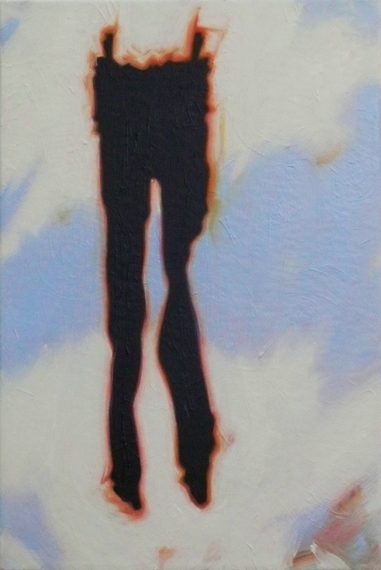
Jill Sykes, Ondoyant, Oil on canvas, 18 x 12 inches
What are some of the themes and ideas present in the works of Oneira: I Dream the Self?
When I sent out the Open Call for the Oneira show, I asked artists to submit work that possessed their personal interpretation of dreaming. It could be unconscious dreams as in dreaming or conscious dreams as in imagination. I looked for pieces that reflected both. I might add here, that we received hundreds of submissions from women artists all over the world.
There were way too many submissions for me to handle myself. I asked my esteemed colleagues, Betty Ann Brown, Ph.D, Professor of Art History, California State University, Northridge and Ada Pullini Brown, Associate Professor of Art, Rio Hondo College, Whittier, CA, to assist me in jurying the show. We were astounded at the quality of work we received: it was truly impressive.
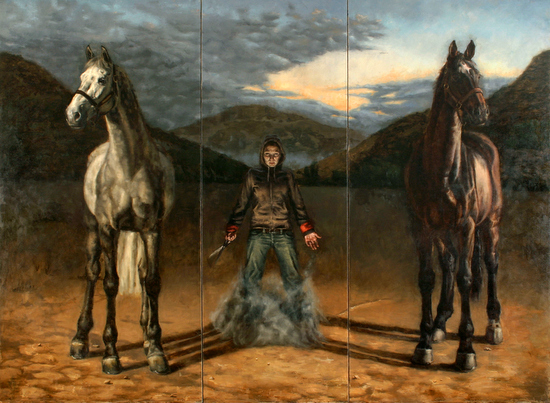
Carolin Peters, Summoned, Oil on canvas, 84 x 114 inches (triptych)
I believe that some of this work has a varietal quality. Some work had similar characteristics of dreamscapes or characteristics that we might experience in normal dreaming but there was also a psychological element to the work. For instance, one piece of work, in particular, reflected a personal transition. This is evident, I believe, in Carolin Peters's prodigious painting Summoned. The subject of the painting seems to be of a woman who has walked through the dark night of the soul. She has survived the journey with two powerful steeds, positioned squarely at her side.
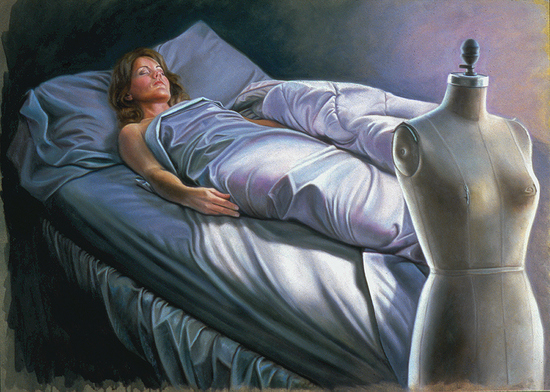
Betty Shelton, The Trouble with Transcendence, Oil on paper, 30 x 40 inches
In another painting, The Trouble with Transcendence by Betty Shelton, a female figure lies motionless on a bed, cocooned in sheets. At the foot of the bed, stands a tattered dress form, looming at us in the foreground. It seems to suggest that we (women) have a difficult time transcending our false image and beliefs about ourselves. It could refer to idealism in beauty or the irrational fear we have of aging.
These kinds of themes were an added bonus to the show. Dreams are mysterious even unnatural by our terms of normal conscious reality, but I believe there are aspects of dreaming that deliver messages to us if we are attentive. This is what I find fascinating about dreaming.
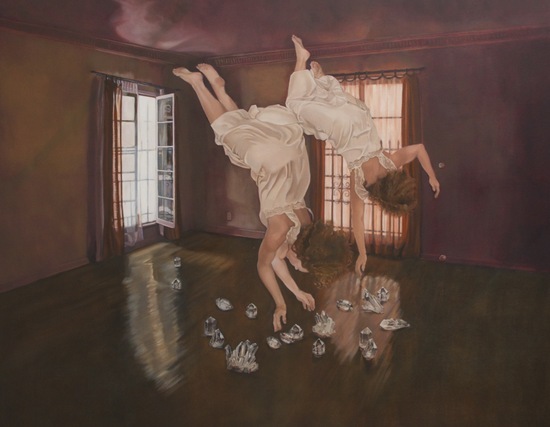
Peggy Nichols, Dream of Crystal Diving, Oil on canvas, 48 x 60 inches
Can you briefly mention and describe a few of the works in the show?
Dreaming is a physical transformation into the unconscious, where our bodies can shape shift into whatever we desire. Tamara Ann Burgh's painting, Important Things Happen in the Woods has that characteristic with a metamorphic feeling. A woman stares back at us intensely, with acid green eyes. Antlers protrude through the top of her head. Her mouth morphs into a hawk's beak. She stands alone, at night, in the woods under a full moon. She exudes the fortitude of a shaman.

Tamara Ann Burgh, Important Things Happen in the Woods, Watercolor, 22 x 18 inches
Many dreams have elements of the past in them. For example; we might dream of objects, such as toys or childhood friends. Seeing yourself as a child is quite common too. In Robin Hextrum's painting, Swept Away, a child's rocking horse floats, listing into the waves. The rocker lies on it's side, ready to submerge into the depths of the water.
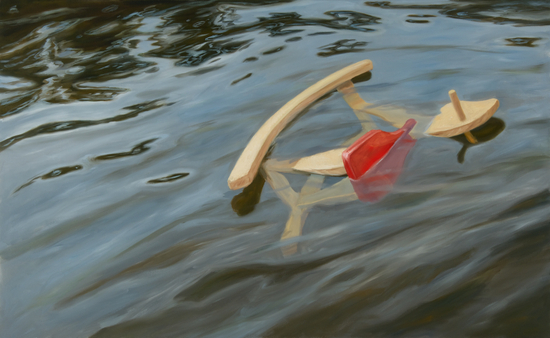
Robin Hextrum, Swept Away, Oil on canvas, 34 x 56 inches

Salem Cade, Ripley's Garden, Oil on canvas, 36 x 32 inches
In Salem Cade's painting, Ripley's Garden, a fair-haired child stands in her Mother's dress, ready to enter a darkened attic room. An opened book, a letter and an old embroidered handbag lie nearby. She seems to represent crossing the threshold of childhood or the loss of innocence.
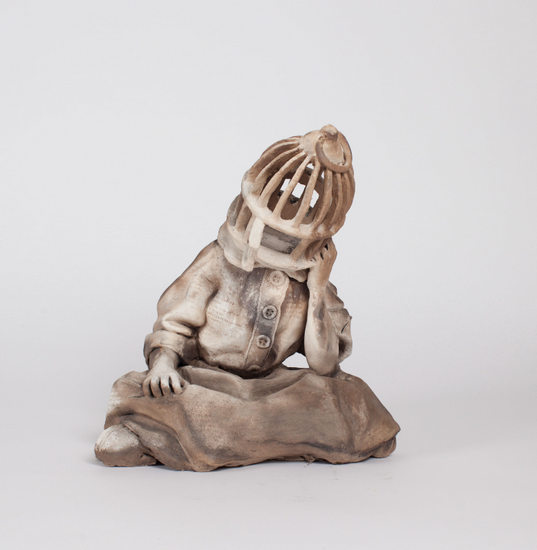
Rowena Hannan, Prokne, Earthenware, 12 1/2 x 11 3/8 x 9 3/4 inches
Rowena Hannan's sawdust fired clay sculpture, titled Prokne, is a figure of a pensive child, sitting cross-legged, with a birdcage shaped head. The door of the birdcage is flung open yet she sits grounded, her apparent freedom unnoticed. Embossed by silkscreen onto the surface of the sculpture, in Greek text, is a prose from a Greek myth.
The story goes. Prokne was the daughter of Pandion, King of Athens. She had a beautiful sister named Philomela. Prokne was betrothed to a cruel husband,Tereus of Thrace. He raped her sister Philomela and cut out her tongue to keep the rape secret. Unable to speak, Philomela weaves a robe to divulge the rape to her sister, Prokne. The sisters plan to revenge the rape by killing Prokne's son and feeding him to Tereus. After Tereus finishes the meal, the sisters produce the head of the beheaded son. He realizes what has happened and pursues the sisters with an axe. As they are about to be overtaken by Tereus, the sisters pray to the Gods to be turned into birds. Prokne is turned into a swallow and Philomela is turned into a Nightingale.
The prose reads: "Sister, my sister, O fleet small swallow. Thy way is long to the sun and the south but I fulfilled my heart's desired."
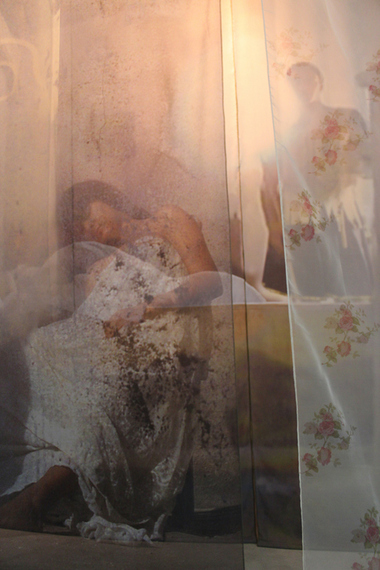
Eleni Lyra, Archangel, Installation with photo, cloth and light (3 sets of hanging panels) 9' 9" x 6' 9"
Eleni Lyra's voluminous installation piece, Archangel, goes a bit further into the
perception of archetypes appearing in dreams. There is a theory that we all dream together, that recurring themes appear over and over in our unconscious mind. For instance, the Archangel is a familiar figure in religion, art and mythology. Eleni's piece encompasses the room with layers of hanging sheer panels, as delicate as gossamer wings, depicting a sleeping woman. An angel appears behind her in radiant light.
She is unaware of the vision as she sleeps in peaceful repose, behind floral curtains. The viewer is the witness of her dream or transformation.
It is often that unusual objects appear in our dreams: something that we might pick up and use but has no functionality.
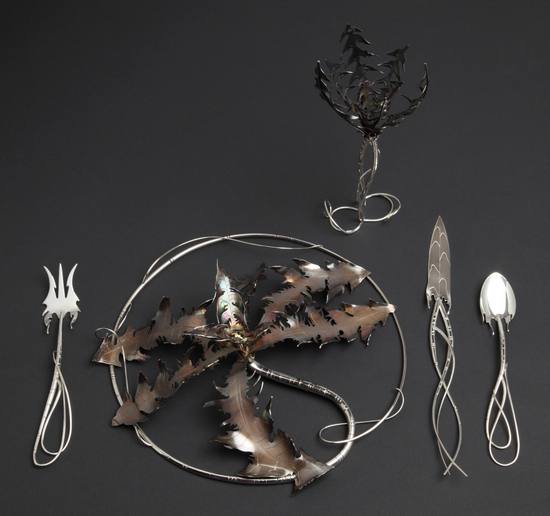
Robyn Nichols, Noxious Lawn Companion. Medicinally complete. Beautifying Contradiction
Sterling silver (fantasy place setting), 16 x 14 x 9 inches
Robyn Nichols's sterling silver fantasy place setting is titled: Noxious Lawn Companion. Medicinally complete. Beautifying Contradiction. The plate and goblet are made of sinewy vines and sharp leaves of a dandelion, in sterling silver. The cutlery is fashioned into shapes that seem to swirl and drip. They seem to be in motion: they are objects that you may not feel like you can get a hold of. Her pieces have no function, other then to marvel at their imposing beauty.
How do you feel about the current situation of women artists, and specifically representational painters?
If you ask the average educated person, which artist they admire the most, they most emphatically will choose a male artist. If you probe further and ask who their favored female artist is, they are hard pressed to say. A majority of the time they will give you a blank stare. Women artists are breezed over in Art history classes. It is a given. This is a real shame.
There may not be many noted women artists recorded throughout history but the few that made the list have been phenomenal artists. We seem to think that the world has changed dramatically better for women and in many ways it has but not so much for women artists, I believe, regardless of what anyone says. Women artists are not held in the same regard as men.
I believe that women artists are getting more exposure then ever before but if you look at statistics it still is not where it should be. I am referring to Micol Hebron's ongoing art project: The Gallery Tally. The statistics do not lie. Getting gallery representation for women artists is difficult.
It is interesting. When I was looking at women artists for the Discipline show, it was very difficult to find figurative artists. I found few woman painters doing figurative, representational work. Most are conceptual artists or abstract painters. This was surprising to me. Are artists inclined to follow trends because it may be easier to get into galleries? I wondered about that. I had a gallery tell me once that they thought I should incorporate street art into my work, such as graffiti before they would consider in handling my work. That floored me. I didn't know what to say. Figurative work can be considered old fashioned.
It seems that Art schools are rarely teaching classical drawing and painting technique these days, so interests lie in other forms of creating work, which is valid. Artists have always been tuned into the higher universe, the cause and flow of what is to come. It matters not, but for me, I am a perpetual student of the classical. I believe wholeheartedly that this is the base from where all artists should start, no matter where they end up.
What are some of the workshops you are planning?
We have three Workshops planned this summer, at Studio C. Karen Atkinson of GYST, Inc. is doing a workshop designed to help guide artists through the important aspects of becoming an organized, professional artist. Then there is a workshop featuring both nude and clothed models in long poses for painters. Finally, Bill Perkins -- an art director at Disneytoons Studio -- will be doing a 3-Day intensive color workshop in late July.
There is information about all of these workshops available on the Studio C Facebook page.
Studio C on Facebook
Oneira: I Dream the Self
Participating Artists: Kaleeka Bond, Shaktima Brien, Ada Pullini Brown, Tamara Ann Burgh, Salem Cade, Rowena Hannan, Pamela Hassell, Robin Hextrum, Laura K. Johnston, Kathryn Jacobi, Eleni Lyra, Mary Ancilla Martinez, Hanneke Naterop, Peggy Nichols, Robyn Nichols, Star Padilla, Sierra Pecheur, Carolin Peters, Serena Potter, Linda Rand, Karrie Ross, Lorraine Serena, Betty Shelton, Jill Sykes, Hope Their, Page Turner, Shelli Tollman, Melora Walters, and Kimberly Webber
After the show closed I was able to interview Peggy and ask her more about her gallery, the exhibition, and the the current situation of women artists.


It's taken some time to find a "real" studio. I lived 20 years in a one bedroom apartment. I substituted a studio with a homemade tent that I had built out in the backyard. It was about the size of a pop up. It was ideal for awhile but became too small a space, as I started to produce larger work.
I have often dreamed of having a sizeable enough studio where I could do my work but also create a salon type atmosphere, where other artists could come teach or share their work. This dream materialized about three years ago when I found a 2,200 sq. ft. studio space available at the Santa Fe Art Colony, in downtown Los Angeles. I jumped at the chance without hesitation.
Studio C Gallery started from doing a two person show with my studio mate. That show received such a great response, I decided to do another show the following year. I had often thought of collaborating with other artists, in organizing a group exhibition. For years, I have been diligent in getting my work shown but gallery representation has eluded me. I've heard the same complaints from other artists, especially women artists. I thought, to myself, "I have the space, what if I go ahead and organize a show regardless and see what happens?"


When I sent out the Open Call for the Oneira show, I asked artists to submit work that possessed their personal interpretation of dreaming. It could be unconscious dreams as in dreaming or conscious dreams as in imagination. I looked for pieces that reflected both. I might add here, that we received hundreds of submissions from women artists all over the world.
There were way too many submissions for me to handle myself. I asked my esteemed colleagues, Betty Ann Brown, Ph.D, Professor of Art History, California State University, Northridge and Ada Pullini Brown, Associate Professor of Art, Rio Hondo College, Whittier, CA, to assist me in jurying the show. We were astounded at the quality of work we received: it was truly impressive.



Dreaming is a physical transformation into the unconscious, where our bodies can shape shift into whatever we desire. Tamara Ann Burgh's painting, Important Things Happen in the Woods has that characteristic with a metamorphic feeling. A woman stares back at us intensely, with acid green eyes. Antlers protrude through the top of her head. Her mouth morphs into a hawk's beak. She stands alone, at night, in the woods under a full moon. She exudes the fortitude of a shaman.




The story goes. Prokne was the daughter of Pandion, King of Athens. She had a beautiful sister named Philomela. Prokne was betrothed to a cruel husband,Tereus of Thrace. He raped her sister Philomela and cut out her tongue to keep the rape secret. Unable to speak, Philomela weaves a robe to divulge the rape to her sister, Prokne. The sisters plan to revenge the rape by killing Prokne's son and feeding him to Tereus. After Tereus finishes the meal, the sisters produce the head of the beheaded son. He realizes what has happened and pursues the sisters with an axe. As they are about to be overtaken by Tereus, the sisters pray to the Gods to be turned into birds. Prokne is turned into a swallow and Philomela is turned into a Nightingale.
The prose reads: "Sister, my sister, O fleet small swallow. Thy way is long to the sun and the south but I fulfilled my heart's desired."

She is unaware of the vision as she sleeps in peaceful repose, behind floral curtains. The viewer is the witness of her dream or transformation.
It is often that unusual objects appear in our dreams: something that we might pick up and use but has no functionality.

How do you feel about the current situation of women artists, and specifically representational painters?
If you ask the average educated person, which artist they admire the most, they most emphatically will choose a male artist. If you probe further and ask who their favored female artist is, they are hard pressed to say. A majority of the time they will give you a blank stare. Women artists are breezed over in Art history classes. It is a given. This is a real shame.
There may not be many noted women artists recorded throughout history but the few that made the list have been phenomenal artists. We seem to think that the world has changed dramatically better for women and in many ways it has but not so much for women artists, I believe, regardless of what anyone says. Women artists are not held in the same regard as men.
I believe that women artists are getting more exposure then ever before but if you look at statistics it still is not where it should be. I am referring to Micol Hebron's ongoing art project: The Gallery Tally. The statistics do not lie. Getting gallery representation for women artists is difficult.
It is interesting. When I was looking at women artists for the Discipline show, it was very difficult to find figurative artists. I found few woman painters doing figurative, representational work. Most are conceptual artists or abstract painters. This was surprising to me. Are artists inclined to follow trends because it may be easier to get into galleries? I wondered about that. I had a gallery tell me once that they thought I should incorporate street art into my work, such as graffiti before they would consider in handling my work. That floored me. I didn't know what to say. Figurative work can be considered old fashioned.
It seems that Art schools are rarely teaching classical drawing and painting technique these days, so interests lie in other forms of creating work, which is valid. Artists have always been tuned into the higher universe, the cause and flow of what is to come. It matters not, but for me, I am a perpetual student of the classical. I believe wholeheartedly that this is the base from where all artists should start, no matter where they end up.
What are some of the workshops you are planning?
We have three Workshops planned this summer, at Studio C. Karen Atkinson of GYST, Inc. is doing a workshop designed to help guide artists through the important aspects of becoming an organized, professional artist. Then there is a workshop featuring both nude and clothed models in long poses for painters. Finally, Bill Perkins -- an art director at Disneytoons Studio -- will be doing a 3-Day intensive color workshop in late July.
There is information about all of these workshops available on the Studio C Facebook page.
Studio C on Facebook
Oneira: I Dream the Self
Participating Artists: Kaleeka Bond, Shaktima Brien, Ada Pullini Brown, Tamara Ann Burgh, Salem Cade, Rowena Hannan, Pamela Hassell, Robin Hextrum, Laura K. Johnston, Kathryn Jacobi, Eleni Lyra, Mary Ancilla Martinez, Hanneke Naterop, Peggy Nichols, Robyn Nichols, Star Padilla, Sierra Pecheur, Carolin Peters, Serena Potter, Linda Rand, Karrie Ross, Lorraine Serena, Betty Shelton, Jill Sykes, Hope Their, Page Turner, Shelli Tollman, Melora Walters, and Kimberly Webber
